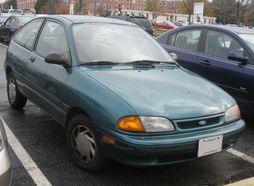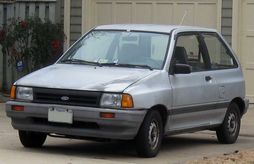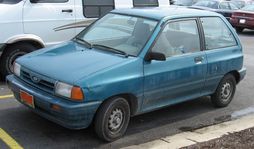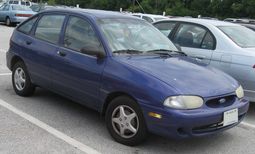The History Of Mazda FORD Festiva MINI Wagon

The Ford Festiva was a subcompact car sold by the Ford Motor Company in North America, Asia and Australasia, introduced in 1986 in Japan. The car was manufactured by South Korean automaker Kia, which at the time was part-owned by Ford, and was based on the Kia Pride.
It was based on the Mazda DA platform, using Mazda's B Series four-cylinder engines. In later models fuel injection was used.
The Festiva was sold in North America from the 1988 to the 1993 model years. It was also sold in Europe and other markets (probably to avoid competition with the Ford Fiesta sold in these markets) as the Mazda 121 from February 1988 until 1991, when it was replaced by a rebadged Autozam Revue. It was sold as the Kia Pride in some regions. It replaced the Ford Fiesta in North America.
The first generation Mazda Demio was also sold in Japan as the Ford Festiva Mini Wagon.
In 1986, the subcompact Festiva was introduced in Japan, and it was introduced to North America and Europe (as the Mazda 121) in 1988. This Festiva sold well, and it fit into Ford's new marketing agenda of selling better built cars. Early in its life, it faced tough competition from the Yugo, which was slightly larger, and only cost $3,990 USD, but the Yugo quickly fell due to reported reliability problems. Initial sales were good, but by the 1990s, Festiva sales started to fall.
Festiva models sold in Japan and Mazda 121 models exported to Europe were built by Mazda in Japan. North American models were built under license by Kia Motors in Korea. After the original 121 model was discontinued in Europe, Kia started selling the Festiva as the Kia Pride — the first Kia model to be sold in this market.
The SHOgun
In 1990, Chuck Beck of Special Editions and Rick Titus took seven Festivas, gutted the interiors, and mounted Ford SHO 3.0L V6s behind the front seats to make the car mid-engined. There were substantial cosmetic and mechanical changes, including relocating the gas tank to the front of the car, structural bracing and improvements to the chassis, adding wider wheel arches to accommodate a wider stance and larger tires, and a complete redesign of the suspension. These changes resulted in a car that could accelerate from 0-60 mph in 4.6 seconds, travel the ¼ mile (0.4km) in 12.9 seconds at 100.9mph (162km/ h), and could achieve a lateral acceleration figure ranging from .95 to 1.04g. Of the seven, Jay Leno owns the silver one, which is number 3.
Special Editions SHOgun #001 - Ron Gallo Special Editions SHOgun #002 - location unknown Special Editions SHOgun #003 - Jay Leno Special Editions SHOgun #004 - Rob Cook Special Editions SHOgun #005 - KJ Byrnes Special Editions SHOgun #006 - location unknown Special Editions SHOgun #007 - Chico "RangerPowerSports member"
Main article: Ford Aspire and Kia AvellaThe second model Ford Festiva was jointly developed between Kia and Ford USA, retaining most of the mechanical parts of the previous model with a more rounded body style designed in USA.
Depending on the market, some retained the SOHC, throttle-body injected motor, while others received an engine with a DOHC cylinder head and MPI designed also by Mazda.
While it was sold in certain markets as a second generation Festiva, Ford renamed it the "Aspire" in North American markets. The Ford Aspire was the first car in its class (in North America) to have standard dual air bags and optional 4-wheel ABS. This new Festiva was slightly longer, wider, and more aerodynamic[citation needed].
For 1997, the Festiva/ Aspire received a new front bumper with an oval grille, in keeping with styling of the Ford Contour and the redesigned Ford Taurus. The Aspire was dropped from the Ford range in the United States after 1997.
The second generation Festiva continued to be sold in Australia until at 2000 when it was replaced by the Ford Ka.
It is interesting to note that Australian second-generation Festivas have US side marker light cut-outs on each side of the vehicle (driver-side and passenger-side) at the front and rear. Instead of housing orange reflectors/ lights at the front sides and red reflectors/ lights at the rear sides, there are non-lit orange reflectors at all four locations. These redundant reflectors, coupled with the orange side indicator repeater (which is not required in the US, and was not included on the Aspire) make for a unique side profile.
Kia developed their following model, the Kia Rio, completely independently, and finished their relationship with Ford.
In Australia, the 1987-93 and 1994-1997 Ford Festivas were assessed in the Used Car Safety Ratings 2006 as providing "significantly worse than average" protection for their occupants in the event of a crash.
From Wikipedia, the free encyclopedia
More About Mazda FORD Festiva MINI Wagon




|